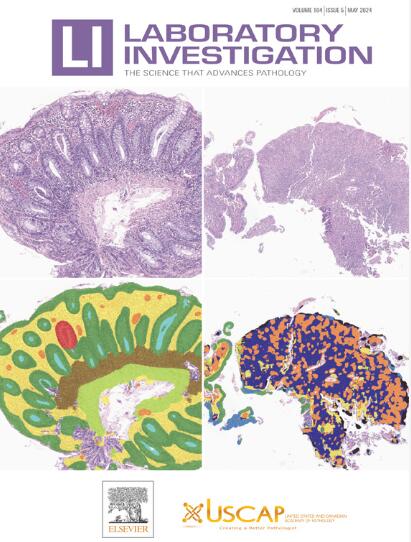脂肪性胰腺疾病:一项冷冻组织的综合研究显示,小叶间/小叶内、腺泡内和胰岛内的脂肪沉积存在明显的区室。
IF 4.2
2区 医学
Q1 MEDICINE, RESEARCH & EXPERIMENTAL
引用次数: 0
摘要
肥胖相关疾病和脂肪代谢紊乱是一些最常见的健康挑战。在这种复杂的情况下,最近的证据表明出现了一种与胰腺脂肪堆积有关的疾病,通常被称为脂肪性胰腺疾病。本研究旨在阐明胰腺内脂肪沉积的不同区室。该研究队列由100例接受胰腺手术切除的患者代表。胰颈缘用苏木精-伊红染色评估组织组成,用Oil Red O(一种脂肪特异性组织化学染色,突出脂滴作为红色信号)评估细胞内脂肪的存在。两个病例也用电子显微镜分析作为横断面验证。在组织组成方面,最常见的是正常胰腺实质(平均值:71.8%),其次是纤维化(17.3%)和小叶间/小叶内脂肪(10.9%)。关于细胞内脂肪沉积,大多数患者存在油红o阳性的胞浆内脂滴。脂肪沉积水平最高的组织区域是朗格汉斯胰岛,神经内分泌/岛细胞更常见地表现为弥漫性脂肪堆积(约占细胞的75%)。电镜检查证实在神经内分泌/岛细胞中存在胞浆内脂泡。我们的研究结果表明,在组织组成和细胞内区隔化方面,胰腺内脂肪沉积存在不同的区隔。了解胰腺脂肪沉积的机制对于提高对脂肪性胰腺疾病的认识至关重要,也为脂质代谢的研究和脂肪相关疾病的治疗开辟了新的视角。本文章由计算机程序翻译,如有差异,请以英文原文为准。
Fatty Pancreas Disease: An Integrated Study on Frozen Tissues Shows Distinct Compartments of Interlobular/Intralobular, Intra-Acinar, and Intra-Islet Fat Deposition
Obesity-related diseases and perturbations of fat metabolism represent some of the most common health challenges. In this complex scenario, recent evidence has suggested the emergence of a condition related to fat accumulation in the pancreas, which is generally referred to as fatty pancreas disease. This study aimed to clarify the different compartments of intrapancreatic fat deposition. The study cohort is represented by 100 patients who underwent pancreatic surgical resection. The pancreatic neck margin was analyzed with hematoxylin and eosin for evaluating tissue composition and with Oil Red O, a fat-specific histochemical staining, highlighting lipid droplets as red signals, for evaluating the presence of intracellular fat. Two cases were also analyzed with electron microscopy as cross-sectional validation. Regarding tissue composition, the most prevalent component was normal pancreatic parenchyma (mean value, 71.8%), followed by fibrosis (17.3%) and interlobular/intralobular fat (10.9%). Regarding intracellular fat deposition, Oil Red O–positive intracytoplasmic lipid droplets were present in most patients. The tissue areas with the highest levels of fat deposition were Langerhans’ islets, with neuroendocrine/insular cells showing more commonly a diffuse pattern of fat accumulation (>75% of cells). Electron microscopy confirmed the presence of intracytoplasmic lipid vacuoles in neuroendocrine/insular cells. Our findings showed the presence of different compartments of intrapancreatic fat deposition, both in terms of tissue composition and intracellular compartmentalization. Understanding the mechanisms of fat deposition in the pancreas is crucial toward improving the general knowledge on fatty pancreas disease, also opening new perspectives for the study of lipid metabolism and the treatment of fat-related diseases.
求助全文
通过发布文献求助,成功后即可免费获取论文全文。
去求助
来源期刊

Laboratory Investigation
医学-病理学
CiteScore
8.30
自引率
0.00%
发文量
125
审稿时长
2 months
期刊介绍:
Laboratory Investigation is an international journal owned by the United States and Canadian Academy of Pathology. Laboratory Investigation offers prompt publication of high-quality original research in all biomedical disciplines relating to the understanding of human disease and the application of new methods to the diagnosis of disease. Both human and experimental studies are welcome.
 求助内容:
求助内容: 应助结果提醒方式:
应助结果提醒方式:


